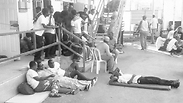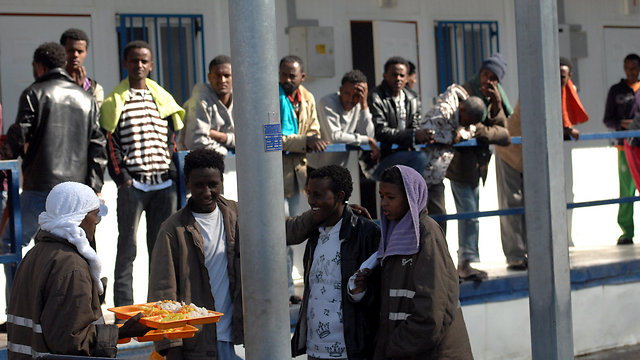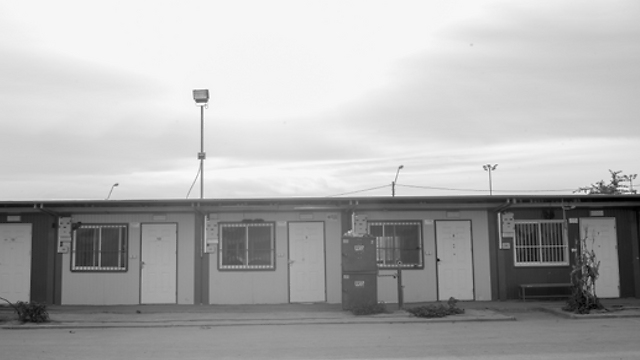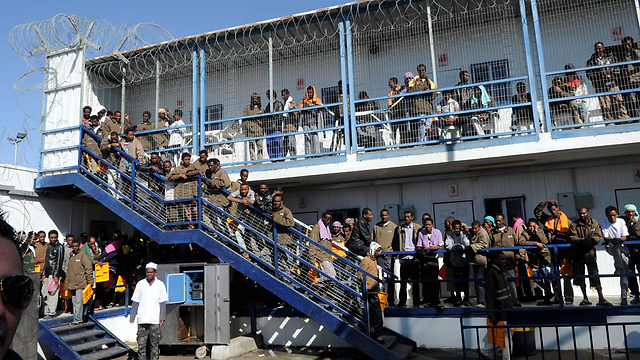
Report: 2.20 meters of living space per asylum seeker
The Refugee and Immigrant Center inspected the conditions in detainment centers, reporting that each room in the Saharonim facility houses 10 people – twice the intended number.
The report's findings are based on information given after freedom of information requests, official reports, and 72 personal interviews the RIC conducted with detainees. The Israeli Prison Service (IPS) rejected the report, calling it biased and non-realistic.
Interviews with detainees at Saharonim indicate that ten people are housed in each room, even though the facility's plans call for just five to be placed in each such space. The report states that each detainee has just 2.2 meters of living space – half of what's required by current IPS regulations, and a quarter of what's considered the standard in other advanced nations.

Freedom of movement
According to the report, detainees at Saharonim are allowed to be outside their rooms from 6am to 10pm, only reporting for counts. However, the yard exit from the facility's new building, Building C ("Mivne Gimel"), leads to an inside-space that does not admit sunlight. Detainees of Holot are allowed to leave the facility between 6am and 10pm, but since Holot is far away from most other places, and since the detainees are not allowd to work and have trouble paying for public transportation, they are forced in practice to stay near the facility. Yahalom does not have a joint space for detainees.
The report indicates that all four facilities feature severe deficits in translation services provided to detainees in meetings with officials. Most interviewees at Holot said they had never been aided by a translator during doctor's visits.

Health services
Some of the Saharonim and Givon detainees said that even though they asked for medical attention they either did not receive it or were not helped by it. Most of the detainees weren't aware of the availability of mental health or social worker services.
Yahalom, which is mostly used as a short-term detainment center, does not provide medical services. Most of its detainees, including families and children, don't get to meet a mental health professional during their detention. In cases of severe medical problems, detainees are taken to the nearest hospital.
Food trouble
Saharonim and Givon saw just a quarter of their inhabitants complaining about small amounts of food, but the case of Holot was much worse – a majority of those interviewed claimed the facility had insufficient supplies of food. One interviewee said that ever since he came to Holot, he goes to bed hungry – which he claims did not happen when he was at Saharonim. In addition, the detainees at Saharonim and Holot complained about the food's quality. Holot saw detainees complain that the food was inedible at times or uncooked.
Other complaints in the report regard a shortage of clothing and hygiene prducts, as well as the lack of care shown to basic detainee needs during long wait periods ahead of hearings.
The report's authors, Sam Kutner and Sigal Rosen, emphasized that while UN guidelines say that arrests and detentions are an extraordinary measure, which can only be justified to achieve a proper goal, it seems that Israel's policy in the past decade has been to use detention and arrests in a frequent manner, disregarding UN instructions.
The IPS said in response, "This is a biased report, with recycled claims that have been raised and refuted in the past. The report does not reflect reality in the detention centers, and we have no intention of responding to the claims raised in it beyond that."
The Population, Immigration, and Border Authority refused to comment on this report.











